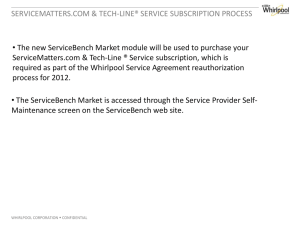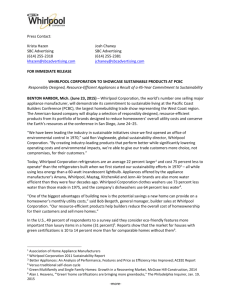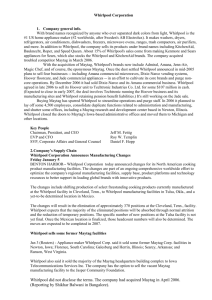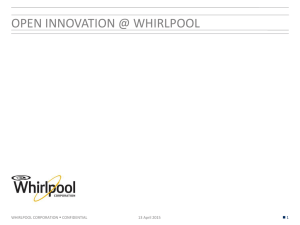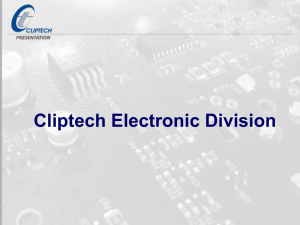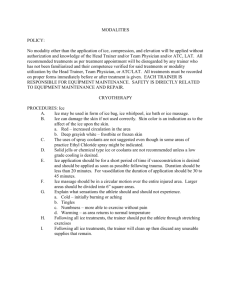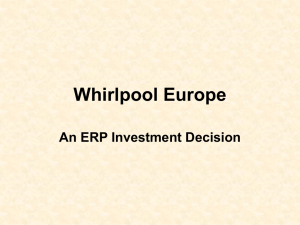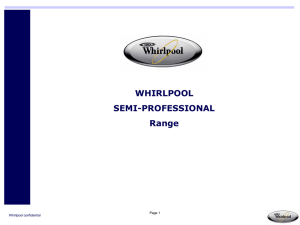170 Paper - Carter Oswood
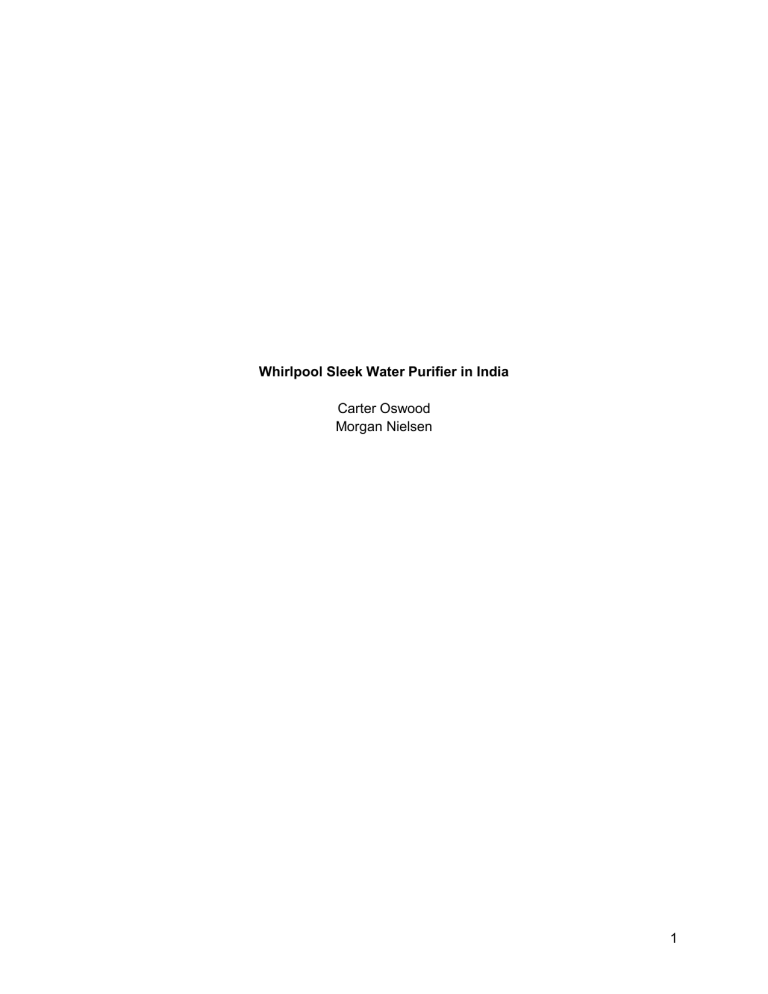
Whirlpool Sleek Water Purifier in India
Carter Oswood
Morgan Nielsen
1
Table of Contents
Executive Summary
Introduction
Country Choice
Consumer Profile
Entry Strategy
Product
Pricing
Distribution
Promotion
References
Appendices
9
10
10-11
12
13-14
6
7
8-9
3-4
5
5-6
2
Executive Summary
Whirlpool will be introducing the Sleek, a new product in their line of water purifiers to the
Indian market. The marketing plan and justifications are following.
India was the chosen market of the Sleek for several reasons. The two primary reasons are that India is an emerging market that has a huge growth opportunity and India has poor water quality that is affecting their quality of life. Although India has made progress, a gross disparity in coverage exists across the country. The World Bank gives the estimate that 21 percent of the drinking water in India is unfit for drinking; there are 128 million people that lack unsafe water ("India," 2012). The Whirlpool Sleek makes it easy and affordable for people to treat water in their homes. Since this is of the utmost concern for a growing population, India is the number one choice for this product.
The Sleek will be inexpensive, easy to use, and fit nicely in all refrigerator doors without losing any of the industrial strength filtration technology. The product will combine the jug water purifiers that are available in the United States with the strong filtration systems used in the
Indian water purifiers. The other major difference from the United States product would be the conversion to the metric system. The manual will be sold in English; however the manual will be available for download online in all 15 official languages of India.
The Whirlpool Sleek water purifier will be the first of its type to enter the market. Since the market is relatively competitive in water purification systems, we will price the product low as a strategy for an increase in sales. We will be selling our product for INR 1,000 (US$18.00).
The Whirlpool Sleek is primarily composed of plastic and its marginal cost to produce is
US$9.00. This cost factors in labor and material including all components. Since the product will be produced in India we will experience significantly lower labor and transportation costs than we would if it was produced in the United States.
3
Whirlpool entered into the Indian market by first participating in a joint venture. However,
Whirlpool quickly saw the benefits that could be achieved by investing in a foreign direct investment. Whirlpool acquired Kelvinator India Limited, which was then later merged with TVS group to form Whirlpool India. Whirlpool now realizes the position as the most recognized brand in home appliances in India and holds over 25 percent of the market ("Corporate info:
Whirlpool," 2010).
Promotions will include outdoor advertisements in the major markets; these ads will be very simple using an image to reach the illiterate population. We will also be in attendance at the largest trade show in India, a 14-day experience, in November, at the Pragati Maidan in
New Delhi, India. This will allow us to interact with consumers, seek out competition and get to know distributors.
4
Introduction
This report will focus on the marketing of Whirlpool’s first household jug water purifier for the Indian market. In India, Whirlpool has only manufactured in-home small appliance water purifiers in the past. However, Whirlpool is combining the industrial strength purification system with a new easy to use portable jug. This will increase the size of potential market of in-home water purification systems. This product will be similar to the products that are offered in the
United States; however the product will be adapted to fit India’s environment and living needs.
With this new marketing strategy, rural India, where water purifiers are needed the most, will also benefit from this new product.
This paper will first discuss India’s marketing environment and why this new product will meet a need. Following that, the entry strategy will be discussed. Finally, we will go into the marketing mix, discussing changes from Whirlpool’s other products and how the marketing mix will change from that employed in the United States.
Country Choice
Being that Whirlpool has such an influence in India, we decided that this would be the best country to introduce our new product. Whirlpool is a recognized name with numerous trusted products, and entering a new design into the mix will give India safer water for a better price. With over 1.2 billion people, this makes India a very appealing country to enter our new product.
We also chose India because it is an economically attractive country. Among the emerging markets, it is the 2nd largest in the world (Jain, 2012). Because of this, Foreign Direct
Investment (FDI) is booming in the country. From America, FDI has increased from US$25 billion to over US$45 billion ("South Asia: India," 2012). Gross national product is around 7% in
India, furthering its attractiveness to foreign investors. All of this points to a promising future for business in India, particularly for a product that has a significant use.
5
The market for water purification systems in India contains some competition. This competition includes; Puerit Water Purifiers, LG and Kent. While these companies hold a percentage of the market, we are optimistic about the introduction of our product. None of these companies offer jug like the Sleek, which provides us with a niche. Our competition is focused on bulky in-home purification systems, which allows us to differentiate in hopes to attract consumers from a broader range.
India’s growing population is putting a strain on all of the country’s resources. For example, the water sources are being contaminated by sewage and agricultural runoff. Although
India has made progress, a gross disparity in coverage exists across the country. The World
Bank gives the estimate that 21 percent of the drinking water in India is unfit for drinking; while there are 128 million people that lack unsafe water ("India," 2012).
The Whirlpool Sleek makes it easy and affordable for people to treat the water in their homes and gives the benefit of reducing uncertainty of contamination. Since this is of the utmost concern, India is the number one choice for this product.
Consumer Profile
Our target market will be 21-65 year-olds. We will focus on those living in New Delhi - population 22 million, Mumbai - population 20 million and Kolkata - population 16 million because that will reach a large number of people ("South Asia: India ," 2012). The number of males and females is relatively similar, and our product is not gender specific. We will appeal to the family, yet the spillover will no doubt be understood by those living alone because our product is useful to everyone.
Language will vary between cities, but English will be spoken and understood in most major cities (Parsa, 2012). The most widely spoken language is Hindi at 41 percent, with
Bengali second at 5.1 percent and Telugu at 7.2 percent ("South Asia: India," 2012).
6
Our target market will have a need for clean water but lack the available funds to buy an expensive in-home water purification system. We will be targeting the middle class that can afford to buy our product. It is hard to estimate the average income being that it varies so vastly, but according to Dr. Parsa it is safe to say it fluctuates around INR $20,000 per month.
Our product is vital to a healthy living environment, and thus is seen as a basic need.
Entry Strategy
In the late 1980s Whirlpool recognized the importance of bringing the business to India.
As an emerging market, Whirlpool was able to foresee the business opportunity in India and decided to enter a joint venture with TVS group to establish the first Whirlpool manufacturing facility in Pondicherry, India ("Corporate info: Whirlpool," 2010).
In 1995, Whirlpool’s success lead to wanting to proceed with a foreign direct investment and acquired Kelvinator India Limited, which led Whirlpool into the Indian refrigerator market.
Later that year, TVS group and Kelvinator were merged into the home appliance leader of the future, Whirlpool India. The merge expanded Whirlpool’s Indian portfolio to washing machines, refrigerators, microwave ovens, and air conditioners ("Corporate info: Whirlpool," 2010).
Whirlpool’s entry strategy decisions proved to be beneficial to the company’s success in the Indian market. Whirlpool now realizes the position as the most recognized brand in home appliances in India and holds over 25 percent of the market. Now there are three manufacturing facilities in Faridabad, Pondicherry and Pune, all of which features an infrastructure that show
Whirlpool’s commitment to consumer interests and advanced technology ("Corporate info:
Whirlpool," 2010).
Whirlpool has recognized several other advantages because of the foreign direct investment. First, they were able to take advantage of the growing market early, which
7
translated to more opportunities for sales. Second, by owning manufacturing facilities in India, the labor wages are significantly lower than the United States. Thirdly, by having Indian personnel working in both the manufacturing facilities and the retail stores, Whirlpool will better understand the culture and customer wants.
Product
Whirlpool’s water purifiers available in India are small appliances that are bulky, electric and expensive ("Water purifier," 2010). However, the Sleek will be inexpensive, easy to use, and fit nicely in all refrigerator doors without losing any of the industrial strength filtration technology.
The Sleek will be clear with a silver filter on top. The jug will be 28 by 21.5 by 11.1 cm, 2.2 liters, holding 1.1 liters of filtered water. This design will allow the jug to fit nicely in the smaller refrigerators that are in India, as seen in Figure 2. The strong filter, while retaining the beneficial fluoride, will filter out sewage, agricultural runoff, chloride tastes and odor, particulates,
Figure 1: Whirlpool Sleek cysts, lead, Atrazine, Lindane, and Turbidity ("Refrigerator water filter 9,"
2012).
This is very similar to the United States product but has a stronger filtration system to fit the poor water quality in India. Another significant difference from the American products would be the conversion to the metric system. However, Whirlpool already has a factory set up in India;
Figure 2: Whirlpool Sleek in refrigerator this will not be an issue.
The operating manual available in the box when the product is purchased will be written in English and Hindi, the most widely spoken languages (Parsa, 2012)
.
However the manual will also be available for download online in all 15 official languages that can be found in Appendix
A.
8
The packaging will be adjusted compared to the American packages as well. However, we will keep the packaging in English. There are many languages spoken in India, however, not one is completely widespread through India. This makes it nearly impossible to create new packages for each language. In India, English is considered a subsidiary official language, but it is the most important language for national, political, and commercial communications.
("South
Asia: India," 2012).
For that reason, we will keep all packaging in English. Similar to the other
Whirlpool products available in India but different than the products in the United States, packaging will use the metric system and not focus on the cold sell. The packaging will have to feature the benefits of the product (Parsa, 2012).
Pricing
The Whirlpool Sleek water purifier will be the first of its type to enter the market. Since the market is relatively competitive in water purification systems, we will use a penetration price strategy (Johansson, 2009). This will entail a low initial price to entice the consumer to use our product. We will be selling our product for INR 1,000 (US$18.00). The Whirlpool Sleek is primarily composed of plastic and its marginal cost to produce is US$9.00. This cost factors in labor and material including all components.
Production will be done at our factories stationed in India, which eliminates the need of exporting shipping costs and tariffs. This price of INR 1,000 for the Sleek is a very strategic price in that our three largest target markets, New Delhi, Mumbai, and Kolkata, have a large urban population with an ever-expanding middle and upper class. The average income of India is marred by a huge gap between classes. According to an Indian native, Dr. Parsa, the income varies astoundingly but INR 1,000 is a very reasonable price. He also said that water purifiers are becoming increasingly popular; and that people are willing to spend money to keep their water safe (Parsa, 2012).
9
American products are favored in India and are seen as being of a high quality, which will give our product a positive country-of-origin (Parsa, 2012). On top of that our product is a affordable and has a trusted name.
Distribution
Whirlpool has already built an extensive list of retailers, seen in Appendix B. We will continue with intensive distribution, by using the current retailers to distribute our new product. Delhi is the city with the most distributors
("Support & services," 2010). As seen in Figure 3, we will utilize our own Whirlpool retail stores, indicated in blue, as well as the other retailers, indicated in black, seen in
Appendix B. Therefore we will utilize a producer-retailer-customer distribution channel and a producer-customer distribution channel,
Figure 3: Whirlpool retailers in
Delhi. depending weather we are shipping to our own retail stores or the outside retailers. In both instances, we will ship the products via truck from the manufacturing facilities in Faridabad,
Pondicherry and Pune, India to the retail stores. This method is advantageous for consumer durable products and gives us control over the process of distribution ("Channels of distributions," 2012)
Promotion
We will be creating an advertising campaign for the new Whirlpool Sleek. The campaign will be focused around the benefits of using a water purifier and the good that can come from it.
Based on research, the most effective medium will be large outdoor advertisements such as billboards. It will be more beneficial than using TV spots because television is not as widespread. Billboards will have a large reach, and even those who cannot read will be exposed to a picture of our product as well as our name (Johansson, 2009).
10
Dr. Parsa confirmed that it would be beneficial to produce this campaign in English. He informed us that many of the advertisements used are a mix of different Indian languages and
English, but that it would be advisable to write the advertisements in English being that the majority of people can speak and read the language (Parsa, 2009).
We have made a mockup of an outdoor advertisement that will be used in the campaign. As seen in Figure 4, it has the
Whirlpool Sleek pouring purified water into a Figure 4: Billboard Mock Up crystal clear glass. The advert r eads, “Cleaner water, for a cleaner world.”
The ad is very connotative in nature and the meaning is simple enough to grasp, even if it is only seen and not read. Other advertisements in the campaign will have this similar message of keeping the planet and our families safe by using our product.
We have also identified a trade show that will gain the most exposure in India. Whirlpool will feature the Sleek at the India International Trade Fair (IITF). IITF is a 14-day experience,
November 14-27, 2012, at the Pragati Maidan in New Delhi, India. With more than 350 companies participating from 25 different countries, it is one of the largest trade shows in South
Asia. Organized by India Trade Promotion Organization, the trade show will have attendees from 73 countries. For vendors it cost INR 400 per day or INR 1500 for the whole event. Entry for attendees is INR 50 per day during the week and INR 80 per day on the weekend ("India international trade," 2012).
References:
Channels of distributions. (2012). Retrieved from http://business.gov.in/manage_business/channels_distribution.php
Corporate info: Whirlpool India . (2010). Retrieved from http://whirlpoolindia.com/corp-india.aspx
11
Support & services | dealer network. (2010). Retrieved from http://whirlpoolindia.com/dealerstorelocator.aspx
"Emerging Economies and the Transformation of International Business." By Subhash C. Jain, .
N.p., n.d. Web. 24 Nov. 2012.
India. (2012). Retrieved from http://water.org/country/india/
India international trade fair (IITF) . (2012). Retrieved from http://www.biztradeshows.com/iitf/
Johansson, Johny K... Global marketing: foreign entry, local marketing, & global management .
5th ed. (international ed. Boston [etc.: McGraw-Hill, 2009. Print.
Parsa, R. (2012, 11 16). Interview by C Oswood & M Nielsen [Personal Interview].
Refrigerator water filter 9. (2012). Retrieved from http://www.whirlpool.com/water-filters/wf401s.html
South Asia: India. (2012). Retrieved from https://www.cia.gov/library/publications/theworld-factbook/geos/in.html
Water purifier. (2010). Retrieved from http://whirlpoolindia.com/product_details.aspx?catid=6
Appendices
Appendix A
12
Official Languages in India
Assamese
Bengali
Gujarati
Hindi
Kannada
Kashmiri
Maithili
Malayalam
Marathi
Oriya
Punjabi
Sanskrit
Sindhi
Tamil
Telugu
Urdu
Appendix B – Distribution
13
